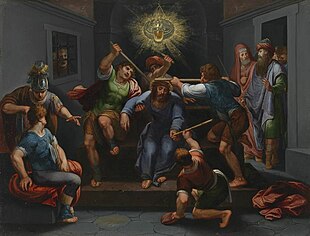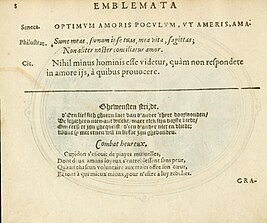Otto van Veen
| |||||||||||||
Read other articles:

Conseil et Commissariat de la CroisadeHistoireFondation XVIe siècleDissolution 1851CadreType Institution sociale, commissionDomaines d'activité Bulle de la sainte croisade, subside ecclésiastique, Excusado ecclésiastiquePays Espagnemodifier - modifier le code - modifier Wikidata Le Conseil de la Croisade (Consejo de Cruzada en espagnol) était un organe de l'administration espagnole existant entre le début du XVIe siècle et le milieu du XVIIIe siècle, moment où il a été…

Bagian dari seriIlmu Pengetahuan Formal Logika Matematika Logika matematika Statistika matematika Ilmu komputer teoretis Teori permainan Teori keputusan Ilmu aktuaria Teori informasi Teori sistem FisikalFisika Fisika klasik Fisika modern Fisika terapan Fisika komputasi Fisika atom Fisika nuklir Fisika partikel Fisika eksperimental Fisika teori Fisika benda terkondensasi Mekanika Mekanika klasik Mekanika kuantum Mekanika kontinuum Rheologi Mekanika benda padat Mekanika fluida Fisika plasma Termod…

This article may require copy editing for grammar, style, cohesion, tone, or spelling. You can assist by editing it. (February 2024) (Learn how and when to remove this message) Comics character Ocean MasterTextless cover of Aquaman #14 (January 2013).Art by Ivan Reis, Joe Prado, and Rod Reis.Publication informationPublisherDC ComicsFirst appearanceAquaman #29 (September 1966)Created byBob HaneyNick CardyIn-story informationAlter egoOrm Marius (current)Orm Curry Marius (Pre-Crisis)Species Atlante…

جو فريزر (بالإنجليزية: Joseph William Frazier) معلومات شخصية الميلاد 12 يناير 1944(1944-01-12)بيافورت الوفاة 7 نوفمبر 2011 (67 سنة)فيلادلفيا، بنسيلفانيا سبب الوفاة سرطان، وسرطان الكبد مواطنة الولايات المتحدة العرق أمريكي أفريقي [1] الطول 182 سنتيمتر الوزن 103 كيلوغرام ال�…

この記事は検証可能な参考文献や出典が全く示されていないか、不十分です。出典を追加して記事の信頼性向上にご協力ください。(このテンプレートの使い方)出典検索?: コルク – ニュース · 書籍 · スカラー · CiNii · J-STAGE · NDL · dlib.jp · ジャパンサーチ · TWL(2017年4月) コルクを打ち抜いて作った瓶の栓 コルク(木栓、蘭&…

Protein-coding gene in the species Homo sapiens LMO1IdentifiersAliasesLMO1, RBTN1, RHOM1, TTG1, LIM domain only 1External IDsOMIM: 186921 MGI: 102812 HomoloGene: 48101 GeneCards: LMO1 Gene location (Human)Chr.Chromosome 11 (human)[1]Band11p15.4Start8,224,309 bp[1]End8,268,716 bp[1]Gene location (Mouse)Chr.Chromosome 7 (mouse)[2]Band7 E3|7 57.21 cMStart108,737,779 bp[2]End108,774,414 bp[2]RNA expression patternBgeeHumanMouse (ortholog)Top expre…

Cette page est une très courte ébauche oubliée. À l'instar du célèbre « Une pomme est un fruit » qui a marqué l'histoire de Wikipédia, n'hésitez pas à la développer (comment ?) Vous pouvez également enrichir les pages proposées dans la rubrique « Pommes à croquer » du bistro du jour. Cet article est une ébauche concernant le sport et le Turkménistan. Vous pouvez partager vos connaissances en l’améliorant (comment ?) selon les recommandations d…

Mathematical model of interest rates A trajectory of the short rate and the corresponding yield curves at T=0 (purple) and two later points in time In finance, the Vasicek model is a mathematical model describing the evolution of interest rates. It is a type of one-factor short-rate model as it describes interest rate movements as driven by only one source of market risk. The model can be used in the valuation of interest rate derivatives, and has also been adapted for credit markets. It was int…

Сельское поселение России (МО 2-го уровня)Новотитаровское сельское поселение Флаг[d] Герб 45°14′09″ с. ш. 38°58′16″ в. д.HGЯO Страна Россия Субъект РФ Краснодарский край Район Динской Включает 4 населённых пункта Адм. центр Новотитаровская Глава сельского посел…

「アプリケーション」はこの項目へ転送されています。英語の意味については「wikt:応用」、「wikt:application」をご覧ください。 この記事には複数の問題があります。改善やノートページでの議論にご協力ください。 出典がまったく示されていないか不十分です。内容に関する文献や情報源が必要です。(2018年4月) 古い情報を更新する必要があります。(2021年3月)出典�…

This article needs additional citations for verification. Please help improve this article by adding citations to reliable sources. Unsourced material may be challenged and removed.Find sources: Monarchism in German-speaking countries – news · newspapers · books · scholar · JSTOR (April 2024) (Learn how and when to remove this message) You can help expand this article with text translated from the corresponding article in German. (April 2024) Click […

Cet article est une ébauche concernant le bois et la forêt, l’archéologie, les Nord-Amérindiens et le Colorado. Vous pouvez partager vos connaissances en l’améliorant (comment ?) selon les recommandations des projets correspondants. Pour l’article homonyme, voir Indian. Indian GrovePrésentationType Bosquet, site archéologiqueCivilisation Utes (?)Patrimonialité Inscrit au NRHP (2000)Smithsonian 5SH1035LocalisationLocalisation Comté de Saguache, Colorado États-UnisA…

2016 single by Stevie Wonder featuring Ariana GrandeFaithSingle by Stevie Wonder featuring Ariana Grandefrom the album Sing: Original Motion Picture Soundtrack ReleasedNovember 4, 2016 (2016-11-04)Recorded2016Length2:40Label Universal Studios Republic Songwriter(s) Ryan Tedder Benjamin Levin Francis Farewell Starlite Producer(s) Ryan Tedder Benny Blanco Stevie Wonder singles chronology Where the Sun Goes (2016) Faith (2016) Real Love (2020) Ariana Grande singles chronology…

World map representing the inequality-adjusted Human Development Index categories (based on 2022 data, published in 2024). 0.800–1.000 (very high) 0.700–0.799 (high) 0.550–0.699 (medium) 0.220–0.549 (low) Data unavailable World map showing more detailed breakdown of countries by inequality-adjusted Human Development Index (based on 2022 data, published in 2024). 0.900–0.910 0.850–0.899 0.8…

Television series VR TroopersAlso known asSaban's VR TroopersGenreScience fictionSuperheroAction/AdventureTokusatsuCreated byHaim SabanShuki LevyToei CompanyBased onSpace Sheriff Shaider,Jikuu Senshi Spielban, & Choujinki Metalderby Toei CompanyStarringBrad HawkinsSarah BrownMichael BaconDavid CarrGardner BaldwinRichard RabagoJulian CombsMichael SorichAaron PrunerZebVoices ofGardner BaldwinKerrigan MahanMichael SorichMike ReynoldsRichard EpcarDave MallowComposersShuki LevyKussa MahchiJeremy …

Comic performer often for children's entertainment This article is about the comic performer. For other uses, see Clown (disambiguation). This article's lead section may be too short to adequately summarize the key points. Please consider expanding the lead to provide an accessible overview of all important aspects of the article. (September 2023) ClownA typical clown of the Western buffoon traditionMediumPhysical comedy, acting, mimeTypescircus, contemporary circus, comedy, theatre, television,…

Mexicaltzingo redirects here. For the Mexico City station, see Mexicaltzingo metro station. For the Guadalajara station, see Mexicaltzingo light rail station. Town & Municipality in State of Mexico, MexicoSan Mateo MexicaltzingoTown & MunicipalitySan Mateo MexicaltzingoCoordinates: 19°12′33″N 99°35′09″W / 19.20917°N 99.58583°W / 19.20917; -99.58583Country MexicoStateState of MexicoMunicipalityMexicaltzingoTown founded1475Municipality founded1869Go…

Stasiun Beran Beran+188 m Eks-Stasiun Beran yang telah menjadi Koramil.LokasiJalan PJKA SlemanTridadi, Sleman, Sleman, Daerah Istimewa YogyakartaIndonesiaKoordinat7°43′12″S 110°21′19″E / 7.7198798°S 110.355311°E / -7.7198798; 110.355311Koordinat: 7°43′12″S 110°21′19″E / 7.7198798°S 110.355311°E / -7.7198798; 110.355311Ketinggian+188 mOperator Kereta Api IndonesiaDaerah Operasi VI Yogyakarta Letakkm 9+487 lintas Yogyakarta-Ma…

ReigenKaisar JepangBerkuasa1663–1687PendahuluGo-SaiPenerusHigashiyamaKelahiran9 Juli 1653Kematian24 September 1732(1732-09-24) (umur 79)PemakamanTaukinowa no misasagi (Kyoto)AyahGo-Mizunoo Kaisar Reigen (霊元天皇code: ja is deprecated , Reigen Tennō) (9 Juli 1654 – 24 September 1732) adalah Kaisar Jepang ke-112. Ia menjadi putra mahkota pada tahun 1654 setelah kematian saudara lelaki tertuanya, Kaisar Go-Kōmyō. Kaisar Reigen memerintah dari 5 Maret 1663 hingga 2 Mei…

Comics character Sargon the SorcererPublication informationPublisherDC ComicsFirst appearance(John) All-American Comics #26 (May 1941) (David) Helmet of Fate: Sargon #1 (April 2007)(Jamini)Constantine #1 (March 2013)Created by(John) John B. Wentworth (writer) Howard Purcell (artist) (David) Steve Niles (writer) Scott Hampton (artist) (Jaimini)Ray Fawkes (writer)Jeff Lemire (writer) Renato Guedes (artist)In-story informationAlter egoJohn SargentDavid John SargentJaimini SargentSpeciesHomo magiTea…







